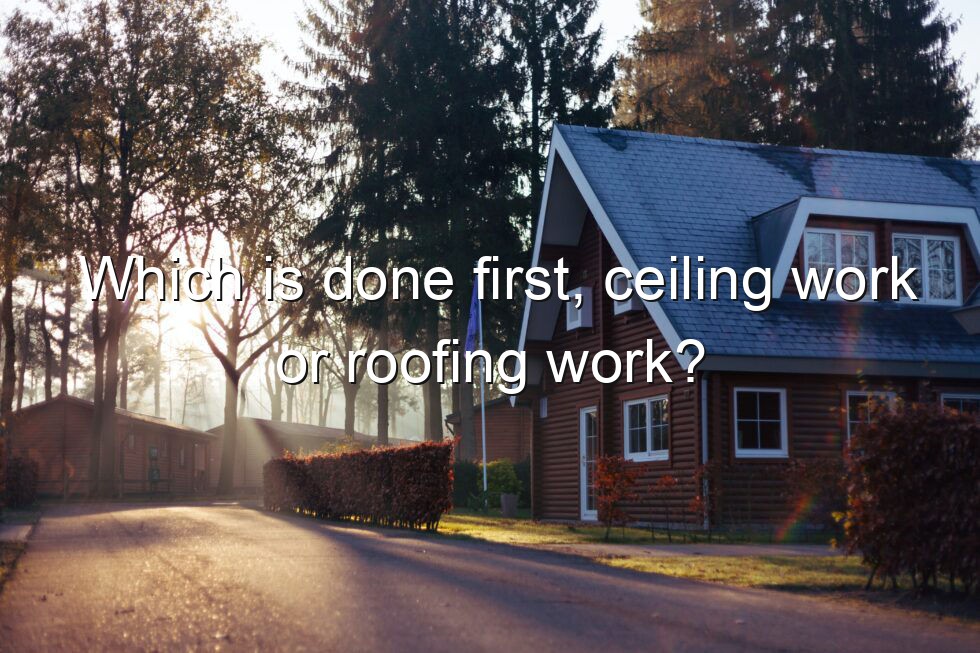Contact us today to ask about our FREE remote Google imaging and/or on-site roofing quotes.
Call us today!
(778) 809-7663
Contact us today to ask about our FREE remote Google imaging and/or on-site roofing quotes.
Call us today!
(778) 809-7663

When it comes to construction, it's not unusual to be faced with the question: "Which is done first, ceiling work or roofing work?" Short answer, prioritize exterior roof repair to prevent further water damage to your home's interior first and then address interior ceiling work after. Ensuring mold, electrical issues and other issues don't persist, effectively prolonging the roof's life and your home's life too.
To properly answer this question, we need to understand the various stages of construction and how each part contributes to the overall project.
Table of Contents
The sequence in which a building is constructed is crucial for ensuring its structural integrity and efficiency.
In some cases, though, the ceiling and roofing work can be performed simultaneously.
For construction projects that involve both ceiling and roofing work, it is wise to tackle the roofing work first, followed by ceiling work.
This is often seen in pre-fabricated buildings, where the roof and ceiling components are assembled together off-site and later joined to the building's structure.
To better understand which is done first, ceiling work or roofing work, it's essential to know the difference between the two.
The ceiling refers to the upper interior surface of a room, which is typically composed of plaster or drywall.

It serves as a barrier between the room and the space above it, often concealing electrical wiring, ductwork, and insulation.
On the other hand, the roof is the exterior covering of a building, providing protection from weather elements such as rain, snow, and sunlight.
Roofs are made from various materials, including asphalt shingles, metal, and clay tiles, and are designed to drain water away from the building effectively. Preventing damage to the home's foundation in the process.
The space between the ceiling and the roof is commonly referred to as the attic or loft.
This area is typically left unused or used for storage purposes, but in some cases, it can be converted into living spaces.
The attic serves as an insulating layer between the interior and exterior environments, helping regulate indoor temperatures and preventing heat loss.
In addition to insulation, the attic also contains vital components such as ventilation systems, electrical wiring, and plumbing.
Proper attic ventilation is crucial in preventing moisture buildup, which can lead to mold growth and structural damage.
Now that we've established the differences between ceilings and roofs, and the importance of the attic space, let's dive into the question of whether the roof is built first.

In traditional construction, the order of operations starts with the foundation, followed by floors, walls, ceiling, and lastly, the roof.
As mentioned earlier, the typical order of construction starts with the foundation, followed by the floors, walls, and then the ceiling.
The roof is typically installed after the ceiling work is complete, ensuring the interior of the building is protected from weather elements.
This approach allows for easier access to the attic space during construction, enabling workers to install insulation, electrical wiring, and other essential components.
However, as mentioned earlier, there are cases in which the roof and ceiling are constructed simultaneously.
This is most common in pre-fabricated buildings or when a building features a unique design that requires a different construction approach.
Before installing the roof, the ceiling work must be completed to ensure a stable and secure connection between the interior and exterior components of the building.
Ceiling work is essential for several reasons:
| Function | Description |
|---|---|
| Insulation | The ceiling serves as a barrier between the living space and the attic, helping to maintain a comfortable indoor temperature by preventing heat transfer. |
| Aesthetics | A well-designed ceiling can enhance the visual appeal of a room, making it feel more spacious and inviting. |
| Safety | A properly installed ceiling helps maintain structural integrity and can prevent the spread of fire, providing valuable protection for the building's occupants. |
| Concealing utilities | Ceilings often house important utilities such as electrical wiring, plumbing, and ductwork. By concealing these components, the ceiling contributes to a clean and uncluttered interior appearance. |
| Acoustic properties | Ceilings play a significant role in controlling the acoustics of a room, either by absorbing sound or reflecting it to create a balanced and comfortable listening environment. |
Once the ceiling work is complete, the focus shifts to the roofing work. A well-constructed roof is critical for the longevity and performance of a building.
Here are some key reasons why roofing work is essential:
| Function | Description |
|---|---|
| Protection | The primary function of a roof is to protect the building and its occupants from weather conditions such as rain, snow, and sunlight, ensuring the interior remains dry and comfortable, reducing the risk of water damage and mold growth. |
| Energy efficiency | A properly insulated and ventilated roof contributes to the overall energy efficiency of a building, reducing heating and cooling costs. |
| Aesthetics | The roof is a significant part of a building's exterior appearance, and choosing the right materials and design can enhance curb appeal. |
| Structural support | The roof provides essential support to the building's structure, distributing weight evenly and preventing potential damage from wind, snow, or other forces. |
| Ventilation | A well-designed roof includes ventilation systems that allow for proper airflow, reducing moisture buildup in the attic and contributing to a healthier indoor environment. |
As mentioned earlier, there are unique situations where the ceiling and roofing work are carried out simultaneously.
These cases often involve pre-fabricated buildings or structures with specific design requirements. Some examples include:
No, the ceiling is not part of the roofing.
The ceiling is the interior surface of a room, while the roofing is the exterior covering of a building, providing protection from weather elements.
No, the ceiling is not the roof.
The ceiling is the interior surface of a room, while the roof is the exterior covering that protects the building from weather elements.
The distance between the roof and ceiling varies, but there is typically an attic or loft space between them, which can range from a few inches to several feet, depending on the building's design and insulation requirements.
The roof on the middle of a house is often called a ridge or ridge line, which is the highest point where two sloping roof surfaces meet.
Flashing is installed between the wall and roof to create a watertight seal and prevent water infiltration, protecting the building from potential damage.
Three common types of ceilings are flat ceilings, cathedral ceilings, and tray ceilings, each with their unique design and aesthetic characteristics.
The framing around the ceiling is called the ceiling joists, which are horizontal structural members that support the ceiling's weight and provide a base for attaching the ceiling material.
Walls that support both the ceiling and roof are called load-bearing walls, as they provide crucial structural support to the building.
The space between the ceiling and the concrete slab is typically referred to as a plenum space, which houses utilities such as HVAC ducts, electrical wiring, and plumbing.
The term "roof" refers to the overall structure that covers a building and provides protection from weather elements.
"Roofing" refers to the materials and components used to construct the roof, such as shingles, metal panels, or tiles.